West Kimberley Region
’It
Was An Uneventful Trip Except For Everything That
Happened’
Quote by Judy
Armstrong, one of our travelling companions for the
trip
 The
Adventure Begins…. We left for our 10 days in the West Kimberley
with a plan to travel the Gibb
River Road and north up the Kalumburu Road
to reach the Mitchell
Plateau and the
aboriginal community of Kalumburu. Along the way we intended to call into
various natural attractions that we had missed on our previous trip into the Kimberley. Our morning tea stop was at Windjana Gorge, about 21 km off the Gibb River Road and about 140 km from Derby. It is an easy walk into the gorge and it was
here we saw at least 75 fresh water crocodiles swimming or sunning themselves
along the shores of the waterholes.
Because there was less water than previous years, the crocodiles had
gathered in numbers making them a great tourist attraction. From Windjana we
made our way to Bell Gorge, a further 125 km along the Gibb River Road and set up camp at Silent
Grove camp ground, 10 km from Bell
Gorge – a pleasant camp ground with cold showers and toilets.
The
Adventure Begins…. We left for our 10 days in the West Kimberley
with a plan to travel the Gibb
River Road and north up the Kalumburu Road
to reach the Mitchell
Plateau and the
aboriginal community of Kalumburu. Along the way we intended to call into
various natural attractions that we had missed on our previous trip into the Kimberley. Our morning tea stop was at Windjana Gorge, about 21 km off the Gibb River Road and about 140 km from Derby. It is an easy walk into the gorge and it was
here we saw at least 75 fresh water crocodiles swimming or sunning themselves
along the shores of the waterholes.
Because there was less water than previous years, the crocodiles had
gathered in numbers making them a great tourist attraction. From Windjana we
made our way to Bell Gorge, a further 125 km along the Gibb River Road and set up camp at Silent
Grove camp ground, 10 km from Bell
Gorge – a pleasant camp ground with cold showers and toilets.
 Oh
No…… Next morning Gary and Judy, our friends from
Ballarat who we were traveling with, found their
fridge had died so a 466 km round trip back to Derby had to be made to buy a brand new Wakeo fridge so we could continue our adventure. Rob and Liz enjoyed a pleasant day at Bell Gorge awaiting their
return. The walk into the gorge is about
1 km to reach the top pool where the water has flowed west from the King Leopold
Range and has cut through
the rock to form a spectacular gorge.
Reaching the bottom pool requires a further 400 metre
walk/climb. We really enjoyed the
afternoon swimming in the bottom pool.
There was
Oh
No…… Next morning Gary and Judy, our friends from
Ballarat who we were traveling with, found their
fridge had died so a 466 km round trip back to Derby had to be made to buy a brand new Wakeo fridge so we could continue our adventure. Rob and Liz enjoyed a pleasant day at Bell Gorge awaiting their
return. The walk into the gorge is about
1 km to reach the top pool where the water has flowed west from the King Leopold
Range and has cut through
the rock to form a spectacular gorge.
Reaching the bottom pool requires a further 400 metre
walk/climb. We really enjoyed the
afternoon swimming in the bottom pool.
There was  water flowing over the falls which was great as the
area had had a “dry wet season” this year. We spent a second day there with Judy and
Gary after their day trip to Derby
and a flat tyre along the way.
water flowing over the falls which was great as the
area had had a “dry wet season” this year. We spent a second day there with Judy and
Gary after their day trip to Derby
and a flat tyre along the way.
We moved onto Charnley River Station for an overnight
stop. This station is 43 kms off the Gibb
River Road.
It’s a family owned working
cattle station with a number of stunning gorges on their property. Our stay here was short but we did get to see
Dillie Gorge (picture left) – a very quiet spot
14 kms from the homestead. From now on we were all on new territory. We had met Judy and Gary in 2000 and traveled
the Gibb River Road
but were unable to reach the Mitchell
Plateau and Kalumburu due to the “big wet” in 2000 so we
were on a mission to do it this year.
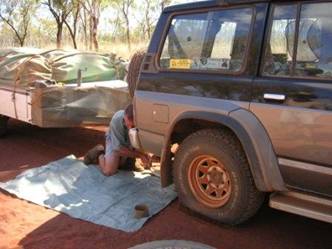 Oh
No Again….. The Mitchell
Plateau is reached via the Pt Warrender, 85 km track off the Kalumburu Road
which is 162 km north of the Gibb
River Road, so we stayed at Drysdale River
Homestead which
is on
Oh
No Again….. The Mitchell
Plateau is reached via the Pt Warrender, 85 km track off the Kalumburu Road
which is 162 km north of the Gibb
River Road, so we stayed at Drysdale River
Homestead which
is on 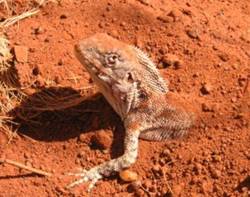 the Kalumburu Road. Our trip to Drysdale River Station was again uneventful
except for Gary and Judy getting yet another puncture. During our pitstop
to change the tyre we made a new friend, a small
lizard half buried in the dust on the side of the road. A cute little character that had no issues
with us taking photos. The roads so far
were what we expected – in parts quite smooth with hardly any
corrugations, but then suddenly the road would change and there would be
corrugations that would make the whole car shake. What we also expected and received in bucket
loads was the famous or infamous Kimberley
red dust, especially when we left the rear door ajar which had the effect of
sucking dust into the rear of the vehicle.
Next morning we set off for the Mitchell Plateau
to set up camp, but little did we know what was ahead.
the Kalumburu Road. Our trip to Drysdale River Station was again uneventful
except for Gary and Judy getting yet another puncture. During our pitstop
to change the tyre we made a new friend, a small
lizard half buried in the dust on the side of the road. A cute little character that had no issues
with us taking photos. The roads so far
were what we expected – in parts quite smooth with hardly any
corrugations, but then suddenly the road would change and there would be
corrugations that would make the whole car shake. What we also expected and received in bucket
loads was the famous or infamous Kimberley
red dust, especially when we left the rear door ajar which had the effect of
sucking dust into the rear of the vehicle.
Next morning we set off for the Mitchell Plateau
to set up camp, but little did we know what was ahead.
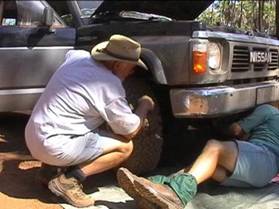 Guess
What, Oh No Again…. We had 188 kms to
travel with the last 18 km, from what we were hearing along the way, being the
worst. A nice morning tea at the King
Edward River and then things went downhill from there. Gary and Judy’s brake line to the front
right hand disc brake of their Nissan Patrol broke which meant instantly, no
brakes. Not a good idea on a single lane
4WD track. This meant some urgent
mechanical repairs had to be undertaken.
He removed the offending part, crimped the pipe and refitted. We now had a Nissan with only one front disc
brake and definite left tendencies.
This took an hour to repair and during that time a car load of
Guess
What, Oh No Again…. We had 188 kms to
travel with the last 18 km, from what we were hearing along the way, being the
worst. A nice morning tea at the King
Edward River and then things went downhill from there. Gary and Judy’s brake line to the front
right hand disc brake of their Nissan Patrol broke which meant instantly, no
brakes. Not a good idea on a single lane
4WD track. This meant some urgent
mechanical repairs had to be undertaken.
He removed the offending part, crimped the pipe and refitted. We now had a Nissan with only one front disc
brake and definite left tendencies.
This took an hour to repair and during that time a car load of  aboriginals traveling along at a ridiculous speed
nearly collected us. They all travel at
incredible speeds on these outback dirt roads which explain why all their cars
are wrecks within months. With all repairs carried out we set off once more
with Gary and Judy leading the way just in case there was any mechanical
problem further along the track, when all of a sudden we come across six packs
of UDL vodka, lime and soda all strewn over the road.
aboriginals traveling along at a ridiculous speed
nearly collected us. They all travel at
incredible speeds on these outback dirt roads which explain why all their cars
are wrecks within months. With all repairs carried out we set off once more
with Gary and Judy leading the way just in case there was any mechanical
problem further along the track, when all of a sudden we come across six packs
of UDL vodka, lime and soda all strewn over the road.
At first, we thought it was the aborigines rubbish, but then quickly realized that it was
Judy’s supply of drinks which had fallen from their camper trailer. Eighteen of the cans lay there with half of
them punctured and squirting vodka, lime and soda everywhere. Rob and I had a lovely time drinking the
rejects as we cleaned up the mess and offered drinks to some of the other 4WD
drivers as they came along. We managed
to luckily rescue 8 undamaged cans for Judy, and gave her a damaged one to
drink as we thought she might need one at this stage. Rob sang ‘Good Old Collingwood
Forever’, Gary’s
football team. He felt it was time for
some light relief after the last hour of drama, even though Melbourne
(Rob’s team) had just beaten Collingwood by 45 points.
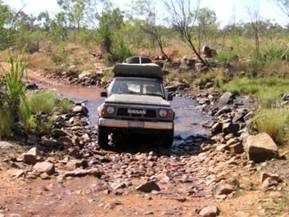 An
Absolute Highlight…… The Mitchell Plateau
track is definitely a 4WD track but not as bad as we expected. There were plenty of corrugations and rough
An
Absolute Highlight…… The Mitchell Plateau
track is definitely a 4WD track but not as bad as we expected. There were plenty of corrugations and rough 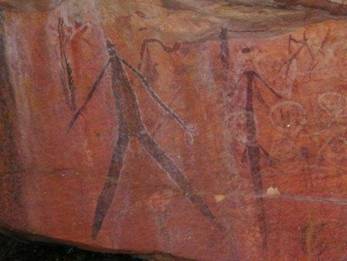 patches, a couple of creek crossings and some nice
little ups and downs but fairly uneventful, although exciting for Gary with
only one front brake and towing a trailer.
What was most outstanding along this track were the Livistona
Eastonii palms that are everywhere. These palms can grow up to 18 metres tall and can be up to 250 years old. The landscape around the plateau varys from mangroves to woodlands and lush rainforest
patches. We decided to walk into the Mitchell Falls and helicopter out, so we set off
quite early the next morning as by lunch time it is very warm. The walk in is 3.3 km and along the way you
come across Little Merten Falls and aboriginal rock
paintings some of which are Gwion or Bradshaw art
(picture) with a minimum age of 17,000 years, and the Wandjina
paintings which depicts headdress, halos, no mouth and a large nose, considered
to be 1000 years old. The 2000 Sydney Olympics used the Wandjina paintings as the aboriginal symbol.
patches, a couple of creek crossings and some nice
little ups and downs but fairly uneventful, although exciting for Gary with
only one front brake and towing a trailer.
What was most outstanding along this track were the Livistona
Eastonii palms that are everywhere. These palms can grow up to 18 metres tall and can be up to 250 years old. The landscape around the plateau varys from mangroves to woodlands and lush rainforest
patches. We decided to walk into the Mitchell Falls and helicopter out, so we set off
quite early the next morning as by lunch time it is very warm. The walk in is 3.3 km and along the way you
come across Little Merten Falls and aboriginal rock
paintings some of which are Gwion or Bradshaw art
(picture) with a minimum age of 17,000 years, and the Wandjina
paintings which depicts headdress, halos, no mouth and a large nose, considered
to be 1000 years old. The 2000 Sydney Olympics used the Wandjina paintings as the aboriginal symbol.
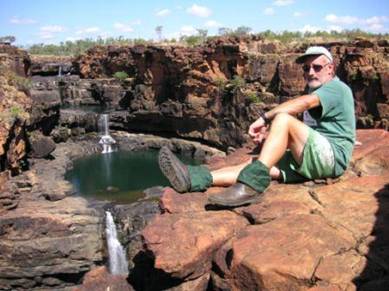 There was not enough water in Little Merten and Big Merten Falls for a
waterfall, but when we reached the top pool of the Mitchell Falls, the water
There was not enough water in Little Merten and Big Merten Falls for a
waterfall, but when we reached the top pool of the Mitchell Falls, the water 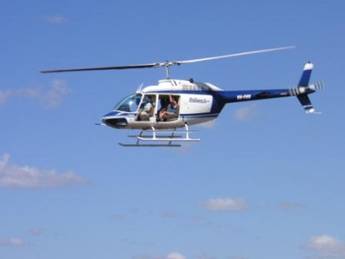 was still cascading over into the Lower Mitchell Falls
and down into the gorge below. It was
well worth the walk in and we spent the next three hours swimming and relaxing
in the upper pool. It was then a
helicopter pick up from the plateau and a 35 minute flight over the falls to
see it from the air, an orbit over Surveyors Pool, and then a bit of crocodile
spotting along the Mitchell River and out to Admiralty Gulf. It was a fantastic flight with the helicopter
flying much lower – this enabled us to get some great video and
photos. We then were brought back to our
camp ground.
was still cascading over into the Lower Mitchell Falls
and down into the gorge below. It was
well worth the walk in and we spent the next three hours swimming and relaxing
in the upper pool. It was then a
helicopter pick up from the plateau and a 35 minute flight over the falls to
see it from the air, an orbit over Surveyors Pool, and then a bit of crocodile
spotting along the Mitchell River and out to Admiralty Gulf. It was a fantastic flight with the helicopter
flying much lower – this enabled us to get some great video and
photos. We then were brought back to our
camp ground.
 Uneventful
Be Damned…… Our adventure that day did not end
there. Just after dinner on our last
night, Rob let out an almighty “holy shit” as a 3.5 metre snake visited our camp site. There was a mad scurry to close the tent
doors as we didn’t feel like sharing our bedroom with this visitor. None of us had ever been so close to such a
reptile. From then on, especially Judy
and Liz were on snake watch. The next
morning we packed up and made the 85 km slow and uneventful trip out to the Kalumburu Road
and turned left to head for Kalumburu, 103 kms further north.
Uneventful
Be Damned…… Our adventure that day did not end
there. Just after dinner on our last
night, Rob let out an almighty “holy shit” as a 3.5 metre snake visited our camp site. There was a mad scurry to close the tent
doors as we didn’t feel like sharing our bedroom with this visitor. None of us had ever been so close to such a
reptile. From then on, especially Judy
and Liz were on snake watch. The next
morning we packed up and made the 85 km slow and uneventful trip out to the Kalumburu Road
and turned left to head for Kalumburu, 103 kms further north.
Is There A Doctor In The House…. The road
deteriorated from then on with a few good patches, lots of corrugations and
rough patches. We arrived in the township of Kalumburu
around lunchtime. What an education that
was! Liz was having problems with an
infected big toe of all things, so we found out where the clinic was located
and fortunately it was open for business.
There were two nurses on duty with a doctor visiting only on
Tuesdays. The clinic consisted of a room
about 10 ft x 12 ft with no particular
waiting room, so Judy and Liz went in and treatment was commenced by one of the
two dogs in the room sniffing the toe then licking the antiseptic that dropped
on the floor. The next minute there were 6 aboriginals, 2 nurses, Liz, Judy, the two
dogs in the room, plus Rob, who decided to come in to see what was going
on. Thank goodness it was only a big toe
that was being treated and not something more personal. We had to laugh as it really was quite funny
with “every man and his dogs” present.
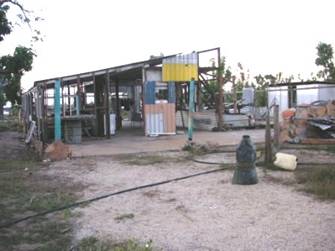 A
Resort, You’re Kidding…. It was then
on to McMahons
Island Beach
“Resort”. This
place was about 15 kms out of Kalumburu
and as we drove Rob commented that it felt like an atomic bomb had gone off and
we were the only survivors. The area had
been hit by cyclone Ingrid in early February and had stripped the trees of
leaves, branches and many trees were uprooted.
It was quite desolate with the exception of a rather large rubbish tip
about 3 km out of town. We reached the
camping area and here there was total destruction of the caretakers
house (picture opposite) and surrounding sheds.
We managed to find two camp sites with million dollar ocean views in the
front and a million dollar total wreckage at the back. There was rubble everywhere.
A
Resort, You’re Kidding…. It was then
on to McMahons
Island Beach
“Resort”. This
place was about 15 kms out of Kalumburu
and as we drove Rob commented that it felt like an atomic bomb had gone off and
we were the only survivors. The area had
been hit by cyclone Ingrid in early February and had stripped the trees of
leaves, branches and many trees were uprooted.
It was quite desolate with the exception of a rather large rubbish tip
about 3 km out of town. We reached the
camping area and here there was total destruction of the caretakers
house (picture opposite) and surrounding sheds.
We managed to find two camp sites with million dollar ocean views in the
front and a million dollar total wreckage at the back. There was rubble everywhere.
The view across the bay and the beach were
really beautiful but unfortunately, there was no swimming due 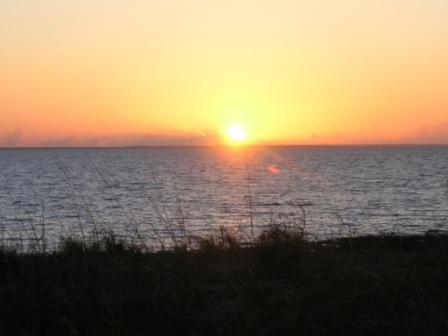 to salt water crocodiles and a shark sighted by Gary the next
morning. Liz and Judy coped
brilliantly. There was one toilet which
needed to be “hand flushed” with a bucket of water and a cold water
shower in the same cyclone damaged out-house.
The shower was quite good. It was
so hot during the day that the water ended up being beautifully warm for a nice
shower. There was one other shower and
toilet attached to the aboriginal’s house which
was in constant use by the campers.
to salt water crocodiles and a shark sighted by Gary the next
morning. Liz and Judy coped
brilliantly. There was one toilet which
needed to be “hand flushed” with a bucket of water and a cold water
shower in the same cyclone damaged out-house.
The shower was quite good. It was
so hot during the day that the water ended up being beautifully warm for a nice
shower. There was one other shower and
toilet attached to the aboriginal’s house which
was in constant use by the campers.
Been There, Seen That…. We spent two days here and visited the township of Kalumburu for repairs to Gary’s vehicle, a few supplies and some
sightseeing. This was an eyeopener. A very
smartly dressed uniformed warden sat outside the takeaway café run by the
Catholic Diocese of Broome. The warden
seemed to be a very shy person and he sat eating his morning tea frightened to
look sideways. His job as stated in the
“Kalumburu Tourist Information 2005”
brochure, was to “escort you off the reserve if you did not comply with
any instructions given to you by the warden”, ie. no alcohol was
permitted to be consumed in the community (a very good idea) and all tourists
had to obtain a $35 entry permit from the Kalumburu
Commission, which was only opened part of the day and not at weekends.
We would have liked to have visited the
museum, but the Catholic priest was on sabbatical leave and was not due back
until 5 July. We also learnt that the
administrator of the township had left and the general store had closed down,
not because of the cyclone, but due to a tax bill of $110,000 and debts of
unpaid grocery bills of $200,000. A new
administrator was due to commence within the next month. It was hoped that he would make a few changes
to the town.
The camp fees were $10.00 per person per
night but the caretakers had “flown the coup” the aboriginal owners
had done the same, so nobody was collecting the fees until the morning we were
packing up. Somebody in the camp decided
to become the self appointed caretaker and was moving into the aboriginal house
and was going to restore law and order.
His name was George and he appeared with no receipt book to collect the
campers money. You can imagine what
happened. The four of us requested a receipt
but we were advised by George that the Aboriginal Commission were unable to
provide him with a receipt book, so we were given two options – paying
the money to George or having an account mailed to us at home. We decided on
the latter.
It Never Rains But It Pours and Pours And
Pours…… We left the township and drove back down to
the Gibb River
where we found a beautiful camp site on the banks of the Gibb River. Little did we know that Broome and Derby had
had an absolute downpour, and Mount Elizabeth Station 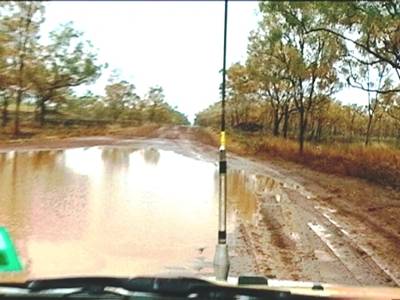 which was 56 kms down from
our camp site had 76 mm (3 inches). We
had a nice camp fire for our last night and another delicious dinner. The meals had been well organized by Judy and
Liz. This was to be our last farewell
before Judy and Gary headed off to Kununurra and Liz and Rob returned to Derby.
which was 56 kms down from
our camp site had 76 mm (3 inches). We
had a nice camp fire for our last night and another delicious dinner. The meals had been well organized by Judy and
Liz. This was to be our last farewell
before Judy and Gary headed off to Kununurra and Liz and Rob returned to Derby.
At 3.50 am that night it started
raining. Just gently with most of the
heavy raindrops coming off the eucalypts.
We awoke to wet tents and decided that it wasn’t too bad and that
we would pack up and continue on. After
10 days of lots of laughter, fun, adventure and “character
building” moments, we said goodbye and went our separate ways. Ten minutes down the Gibb River Road heading back to Derby we hit the rain and
came across puddles and some corrugations filled with water. This started getting worse with the red dust
turning to red mud and the corrugations filling up with water to make the
driving for Rob quite difficult at times.
The car and the windows were covered in red mud with inches of red mud
hanging from the underside of the car.
There was nowhere to pull off the road and wait for the rain to stop so
we continued for 106 kms from the Kalumburu Road
to Mt Barnett Roadhouse where we were to spend the night at Manning Gorge. As you can imagine, Liz was relieved to see
the turnoff to the roadhouse.
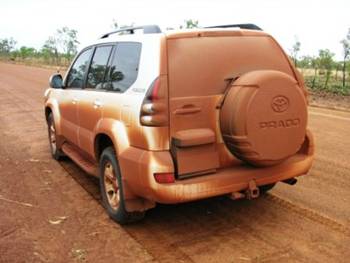 On arrival we learnt that Mount Elizabeth
Station had received 76 mm (3 inches) and Mt Barnett Roadhouse 52 mm (2 inches)
with Manning Gorge and the campers isolated . It was then decision time, and fortunately
Rob talked to two sensible young 4WD drivers and their partners who were
prepared to continue on with us in convoy. We left an hour later and in convoy
with our UHF radios in use, arrived at Galvin’s Gorge where we actually
visited the gorge for sightseeing before proceeding.
On arrival we learnt that Mount Elizabeth
Station had received 76 mm (3 inches) and Mt Barnett Roadhouse 52 mm (2 inches)
with Manning Gorge and the campers isolated . It was then decision time, and fortunately
Rob talked to two sensible young 4WD drivers and their partners who were
prepared to continue on with us in convoy. We left an hour later and in convoy
with our UHF radios in use, arrived at Galvin’s Gorge where we actually
visited the gorge for sightseeing before proceeding.
It was amazing to
see the change in the road conditions.
The road became clear of water in parts but very heavy, mudwise. We continued onto Derby
after the other drivers turned off to Bell
Gorge. We arrived safely in Derby around 5.00pm and had
traveled just over 400 kms for the day. It was great to see the bitumen meet us 63 kms from Derby.
The funny things that happen on the road: At the start
of the Kalumburu
Road we ask the road conditions of a group that
had just come from Kalumburu. We were told it was good with some bad patches
but we should remember: “At the end of every straight section
there was a bend” I didn’t know that! As we left the roadside stop, across the CB
came a ladies voice in another 4WD just driving into the roadside stop and she
said. “Oh look, we can have coffee and cake with the Nanavan”. What is a Nanavan
you ask? A group of older people on an
organized 4WD tour bus way out here in the outback. And the classic statement came from Judy
Armstrong after an exhausting day: “It
was an uneventful trip except for everything that happened” hence the
subtitle for this section of our trip.
We had a clean up in Derby but we still have a very dirty vehicle
which hopefully we will be able to wash in Broome. We are really looking forward to our
forthcoming luxury on the Kimberley
Quest II.
The highlight of this section of our trip
was no doubt the walk into Mitchell
Falls and the helicopter
flight out. You are able to see so much
more in a helicopter (with no doors) than from a light aircraft because it
travels lower and can turn tightly to get a good look at attractions.
 The
Adventure Begins…. We left for our 10 days in the West Kimberley
with a plan to travel the
The
Adventure Begins…. We left for our 10 days in the West Kimberley
with a plan to travel the  Oh
No…… Next morning Gary and Judy, our friends from
Ballarat who we were traveling with, found their
fridge had died so a 466 km round trip back to
Oh
No…… Next morning Gary and Judy, our friends from
Ballarat who we were traveling with, found their
fridge had died so a 466 km round trip back to  water flowing over the falls which was great as the
area had had a “dry wet season” this year. We spent a second day there with Judy and
Gary after their day trip to
water flowing over the falls which was great as the
area had had a “dry wet season” this year. We spent a second day there with Judy and
Gary after their day trip to  Oh
No Again….. The
Oh
No Again….. The  the
the  Guess
What, Oh No Again…. We had 188 kms to
travel with the last 18 km, from what we were hearing along the way, being the
worst. A nice morning tea at the King
Edward River and then things went downhill from there. Gary and Judy’s brake line to the front
right hand disc brake of their Nissan Patrol broke which meant instantly, no
brakes. Not a good idea on a single lane
4WD track. This meant some urgent
mechanical repairs had to be undertaken.
He removed the offending part, crimped the pipe and refitted. We now had a Nissan with only one front disc
brake and definite left tendencies.
This took an hour to repair and during that time a car load of
Guess
What, Oh No Again…. We had 188 kms to
travel with the last 18 km, from what we were hearing along the way, being the
worst. A nice morning tea at the King
Edward River and then things went downhill from there. Gary and Judy’s brake line to the front
right hand disc brake of their Nissan Patrol broke which meant instantly, no
brakes. Not a good idea on a single lane
4WD track. This meant some urgent
mechanical repairs had to be undertaken.
He removed the offending part, crimped the pipe and refitted. We now had a Nissan with only one front disc
brake and definite left tendencies.
This took an hour to repair and during that time a car load of  aboriginals traveling along at a ridiculous speed
nearly collected us. They all travel at
incredible speeds on these outback dirt roads which explain why all their cars
are wrecks within months. With all repairs carried out we set off once more
with Gary and Judy leading the way just in case there was any mechanical
problem further along the track, when all of a sudden we come across six packs
of UDL vodka, lime and soda all strewn over the road.
aboriginals traveling along at a ridiculous speed
nearly collected us. They all travel at
incredible speeds on these outback dirt roads which explain why all their cars
are wrecks within months. With all repairs carried out we set off once more
with Gary and Judy leading the way just in case there was any mechanical
problem further along the track, when all of a sudden we come across six packs
of UDL vodka, lime and soda all strewn over the road.  An
Absolute Highlight…… The
An
Absolute Highlight…… The  patches, a couple of creek crossings and some nice
little ups and downs but fairly uneventful, although exciting for Gary with
only one front brake and towing a trailer.
What was most outstanding along this track were the Livistona
Eastonii palms that are everywhere. These palms can grow up to 18 metres tall and can be up to 250 years old. The landscape around the plateau varys from mangroves to woodlands and lush rainforest
patches. We decided to walk into the
patches, a couple of creek crossings and some nice
little ups and downs but fairly uneventful, although exciting for Gary with
only one front brake and towing a trailer.
What was most outstanding along this track were the Livistona
Eastonii palms that are everywhere. These palms can grow up to 18 metres tall and can be up to 250 years old. The landscape around the plateau varys from mangroves to woodlands and lush rainforest
patches. We decided to walk into the  There was not enough water in Little Merten and Big Merten Falls for a
waterfall, but when we reached the top pool of the Mitchell Falls, the water
There was not enough water in Little Merten and Big Merten Falls for a
waterfall, but when we reached the top pool of the Mitchell Falls, the water  was still cascading over into the Lower Mitchell Falls
and down into the gorge below. It was
well worth the walk in and we spent the next three hours swimming and relaxing
in the upper pool. It was then a
helicopter pick up from the plateau and a 35 minute flight over the falls to
see it from the air, an orbit over Surveyors Pool, and then a bit of crocodile
spotting along the Mitchell River and out to Admiralty Gulf. It was a fantastic flight with the helicopter
flying much lower – this enabled us to get some great video and
photos. We then were brought back to our
camp ground.
was still cascading over into the Lower Mitchell Falls
and down into the gorge below. It was
well worth the walk in and we spent the next three hours swimming and relaxing
in the upper pool. It was then a
helicopter pick up from the plateau and a 35 minute flight over the falls to
see it from the air, an orbit over Surveyors Pool, and then a bit of crocodile
spotting along the Mitchell River and out to Admiralty Gulf. It was a fantastic flight with the helicopter
flying much lower – this enabled us to get some great video and
photos. We then were brought back to our
camp ground. Uneventful
Be Damned…… Our adventure that day did not end
there. Just after dinner on our last
night, Rob let out an almighty “holy shit” as a 3.5 metre snake visited our camp site. There was a mad scurry to close the tent
doors as we didn’t feel like sharing our bedroom with this visitor. None of us had ever been so close to such a
reptile. From then on, especially Judy
and Liz were on snake watch. The next
morning we packed up and made the 85 km slow and uneventful trip out to the
Uneventful
Be Damned…… Our adventure that day did not end
there. Just after dinner on our last
night, Rob let out an almighty “holy shit” as a 3.5 metre snake visited our camp site. There was a mad scurry to close the tent
doors as we didn’t feel like sharing our bedroom with this visitor. None of us had ever been so close to such a
reptile. From then on, especially Judy
and Liz were on snake watch. The next
morning we packed up and made the 85 km slow and uneventful trip out to the  A
Resort, You’re Kidding…. It was then
on to
A
Resort, You’re Kidding…. It was then
on to  to salt water crocodiles and a shark sighted by
to salt water crocodiles and a shark sighted by  which was 56 kms down from
our camp site had 76 mm (3 inches). We
had a nice camp fire for our last night and another delicious dinner. The meals had been well organized by Judy and
Liz. This was to be our last farewell
before Judy and
which was 56 kms down from
our camp site had 76 mm (3 inches). We
had a nice camp fire for our last night and another delicious dinner. The meals had been well organized by Judy and
Liz. This was to be our last farewell
before Judy and  On arrival we learnt that
On arrival we learnt that